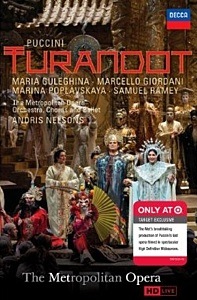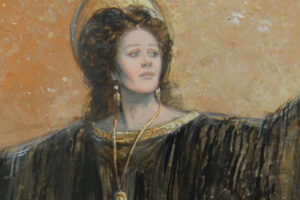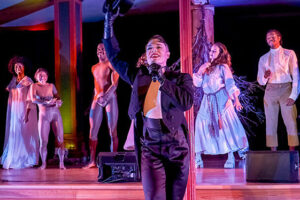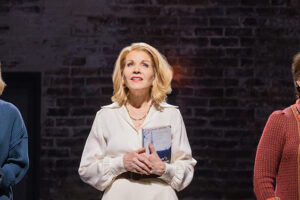

First, I have to confess that I worship this Zeffirelli production of Turandot. It’s nouveau riche tacky like a lottery winner. It’s Vegas. Florenz Ziegfeld would have wept. To the uninitiated among us a production like this can inspire a cataclysmic, religious conversion to the art form. It is Oz. The act two set change is captured here perfectly. The camera pulls back from Ping, Pang and Pong departing their abode into the darkened theater so that when the lights come up on the palace and the populace you get it right between the eyes with both barrels. I was verklempt. This DVD is opera porn.
If only those sets could sing. The Met Chorus probably knows their Puccini backwards by now it’s scheduled so often and they do a wonderful job. Especially in the first act when they’ve got all those yoga moves and broadway fingers going on. The hymn to the moon here is magical, visually and vocally.
Our three ministers this time out are all solid and manage to stay together, no small feat that, and blend. I would have preferred one of the two tenors to have a sweeter voice just for purposes of distinction but, they carry out the constant choreography of their roles so well, it’s quibbling. They still sanction that little cut toward the end of the act II trio at the Met. I’ll never understand why.
Samuel Ramey was nearly 70 when this was broadcast. There are moments as Timur when he does pull it together. The high part of his voice working much better than the low, oddly. His outburst after Liu’s death is good. This is not, however, a positive representation of his gifts for his many fans.
Marina Poplavskaya‘s contribution as Liu is a little harder to gauge. She sings quite well and her phrasing is generous if her performance seems a tad introverted. The top of the voice is bigger than you might expect but, it has a glassy quality and her mouth is very tight in close up. She almost doesn’t look as if she’s enjoying what she’s doing. I’d love to know what her act three would be like if she wasn’t trifled with so much by her colleagues but, more of that anon.
Marcello Giordani is a genetic throw back to the 1950’s. A very good voice married to a mostly good technique with good high notes. He’s really no actor. During the riddle scene you never, and I mean never, actually see the idea flash across his face before he sings out the answer. That seems almost elementary to me, Acting 101. He sings the Operatic National Anthem in the last act well enough.
Apparently Maria Guleghina waited to sing Turandot because she wanted to sing everything else first. I know that there are always caveats in performance for singers with big, wild voices and I’m ready to forgive… a lot. Her first act appearance on the floating barge, er… I mean, palace is a great indicator of what we’re about to get dramatically. As the Prince of Persia presents himself for her judgment she makes that ubiquitous “off with his head” gesture and then turns to her handmaiden on her left and smiles. Never seen that before. Imperious and haughty, yes. Happy and smiling? Wow.
So, this isn’t going to be the “Proud Indian Princess” version.
She shows up for act II in Vegas and fearlessly launches into “In questa reggia” without a hint of nerves. Some phrases are great and some not so much. Some endings are clipped in places where she’s giving too much. After the first riddle she sings the loudest, “Si, la speranza che delude sempre” I’ve ever heard and takes a huge, very unmusical, ritard at the end of what is essentially, a parlando passage. I loved it and I wanted more. Then there’s a little flatness on top at times but the sound, and I almost want to use the word “noise,” coming out of Guleghina is so big, I’m still, very, forgiving.
From the riddle scene on, the very detailed production book has obviously been completely disregarded in place of someone else’s version of good ideas and whatever tenuous connection this production had to a hint of actual Asian theatrical influence is completely lost.
During the third act Guleghina actually walks to the front of the stage while Poplavskaya is singing her final aria and not only regards her at close range but, literally, grabs her face. Stomping all over her performance is unforgivable as far as I’m concerned. Then, when Liu stabs herself, Giordani is right there on top of her and kisses her forehead in someone’s ill-formed idea of compassion. It’s the first time I’ve seen the slave girl bullied by the principals instead of the guards. No wonder she didn’t look happy in the first act.
The ensuing kiss between Giordani and Guleghina is a date rape without the GHB played on fast forward. He grabs her in what turns quickly into a brief lip lock followed by an aborted tango dip, she blocks his face with both hands and then, bam!, she’s flat on the ground and he’s kneeling beside her while the orchestra is still playing through the kiss music. I was more shocked than either of them. Fail.
You all know what happens in the finale and the gold glitter falls from the ceiling. It’s New Year’s Eve every night at the Met.
Conductor Andris Nelsons, having borrowed the keys from Dad for the night, manages to drive the Rolls Royce without bumping into anything.
The DVD of Aida will not detain us long. I’ve seen both these productions in the house but this is grand. Grand like the Canyon: grand. I think it may be one of the few shows to use the entire height of the stage, which itself is impressive. It looks like they borrowed the sets each night from the Egyptian Wing at the Metropolitan Museum of Art. Yet another Act Two scene change here very well captured. With all the spider cams on tracks whizzing about the proscenium sometimes I think it is actually better than being there. In this case a little distance from the stage may be a good thing.
The principals in this cast, close in and on the home screen, are unfortunate looking. I’m being charitable. I had a friend once who picked up an opera recording at my house and surveyed the back cover with all the head shots of the cast, put it back down and said, “Animal Farm.” I won’t belabor the point further. This is Old School Opera. I will say that whenever I see any person of physical substance take the stage there is a part of me that relaxes because I know the only reason they are there is because they can “sang.” Big bodies, big voices. The poor King of Egypt and Ramfis in this production don’t leave an impression because not only are they not distinguished vocally they look undernourished compared to their much louder colleagues.
The weakest link is Carlo Guelfi, who succumbs to a very bad case of the wobbles right from the start and it doesn’t improve much. He is, however, almost the only person on stage taller than our soprano heroine. Violeta Urmana has been singing soprano roles for six years and I’m still not convinced. Even when she gets the fake place on the top of her voice working by the end of the Nile scene there’s never any float. Above the staff for most of the role she’s strident and pinched and the sound is monochromatic. She doesn’t ride the ensembles which is a criminal offense in Verdi as far as I’m concerned. Her “O patria mia” is even more ungainly than the get up they make her wear, which looks like it was stolen out of Stevie Nick’s closet on her last concert tour. If I was singing the role I’d pay the wardrobe mistress to drive that dress outside the city limits and shoot it.
Johan Botha has a genuinely splendid sound, and again, as the performance progresses he starts really ringing out. His Verdi phrasing is mostly square and clumsy. One oddity is his rare, for a tenor, observation of Verdi’s piano marking on the B-flat that ends “Celeste Aida” but, he then barrels he his way through the same note on “amori” in the Nile duet when he’s in much firmer vocal estate. It’s a Germanic not a Latin voice and there’s definitely a Tristan in there. He’s more concerned with his vocalism than his acting which is probably a blessing as that’s where his gifts lie.
I unknowingly attended Dolora Zajick‘s San Francisco Opera debut in 1984 in Aida. On that occasion Leontyne Price was the heroine and Ms. Zajick sang the Act One role of the offstage temple priestess. Within four years she had made her Met debut as Azucena and now nearly 30 years have passed and she is still singing the same dramatic repertory with little diminishment of her resources. It is an astonishment. She is well represented in this role, and in this same production, from 1989 on DVD and she gives a very similar performance here. The voice literally rolls out of her on the bottom and although you can see she’s working harder at it’s still little effort compared to the majority of her colleagues. She does a good bit of dominating the ensembles herself which is almost unheard of for a mezzo. Her acting is simple and old school but, her characterization grows through the course of the performance and by the end of the Judgment scene when she’s supplicant before the priests she is a true figure of tragedy.
The only thing new about this mounting is the choreography of the ballets by Alexei Ratmansky who was the head of the Bolshoi. Most excellent divertissement during the Triumphal Scene especially with the Busby Berkeley cam from overhead. No kidding. The chorus just stands and sings through the whole show.
I heard reports that the conductor, Daniele Gatti, was booed at his curtain call at the first performance of this run and, other than his doing some very odd things with the string section and their articulation during the duet between Amonasro and Aida, I cannot imagine why. It’s the big band sound that this production requires and he’s driving the Rolls Royce.
Oh, and the bows. Just the group calls on the Turandot at the end, boo; but all the bows on the Aida which sometimes I think are the best part of any performance. Aunties Patricia and Renee do the color commentary backstage, respectively, and I keep waiting for a football game to start. I love all the backstage shots though and it’s almost worth the price just to see all of the sets being assembled and broken down with the interviews.
The bit rate on both of these DVD’s is the lowest I have ever seen and you actually have to turn down the sharpness on a large monitor to get a picture free of pixels. Very bad form for Decca. Target, I’d guess is the actual culprit here though, since these pressings only have English as the subtitle option and who needs ’em? Obviously rubbed out on the cheap and not the printings meant for international distribution. Sound is excellent and DTS options are there.
If you’re a fan of either of these productions you might want to wait for the actual Decca releases in July.























Comments